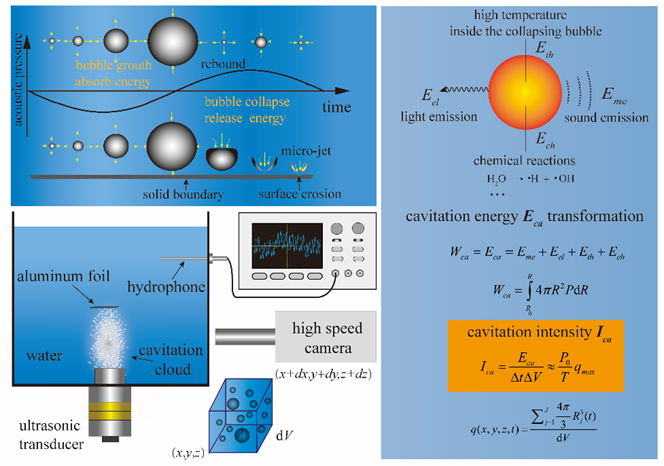Cavitation usually refers to the generation and subsequent dynamic behaviors of cavities when liquid suffers from a sufficient pressure drop. Because of the physical effects including high temperature and pressure, shock wave and micro jet during the collapse of cavitation bubbles, cavitation has been widely used in sonochemistry, biomedical, environmental science and other areas.
Over the past decades, cavitation intensity has already been used as a self-evident definition charactering the activity or strength of cavitation. Chemical, acoustic, optical and mechanical method were developed to measure the cavitation intensity. However, the above-mentioned methods could only reflect one of the effects of cavitation. Consequently, the measurement results using different methods could be hardly compared with each other. It is necessary to confirm a clear and universal definition of cavitation intensity.
Recently, from the point of view of energy, researchers from the Institute of Acoustics of the Chinese Academy of Sciences (IACAS) proposed a generalized definition of cavitation intensity, and also derived an appropriate formula to calculate the cavitation intensity.
The cavitation intensity Ica was defined by the power density of cavitation(Figure 1). Researchers found that the cavitation intensity could be characterized by q, namely the state variable of cavitation. The influence factors of cavitation intensity were intricately related to the surrounding liquid environment, ultrasonic frequency and pressure, bubble size and so on. Therefore, in the fixed liquid environment and bubble nuclei condition with certain sound pressure amplitude, a specific ultrasonic frequency might maximize the cavitation intensity.

Figure 1. Illustration on the definition of cavitation intensity and its measure method. (Image by IACAS)
The study, published in Ultrasonics Sonochemistry, was supported by the National Natural Science Foundation of China.
Reference:
WU Pengfei, BAI Lixin, LIN Weijun. On the definition of cavitation intensity. Ultrasonics Sonochemistry, 2020, 67(105141). DOI: 10.1016/j.ultsonch.2020.105141.
Contact:
ZHOU Wenjia
Institute of Acoustics, Chinese Academy of Sciences, 100190 Beijing, China
E-mail: media@mail.ioa.ac.cn


